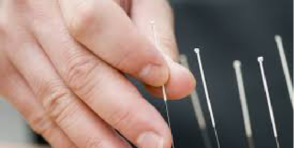Dry Needling vs Acupuncture
The differences between acupuncture and therapeutic dry needling truly outweigh their similarities. Dry needle treatment, also known as Therapeutic Dry Needling (TDN) or dry needle therapy uses filiform needles to treat western medical neuromusculoskeletal diagnoses at myofascial points. TDN needle point selection is based on diagnosis, palpation and functional testing, and general foundational belief is rooted in the science of the nervous system governing homeostasis in the body, and the methodology of affecting this through needling myofascial points. Acupuncture uses similar filiform needles to treat virtually any diagnosis in Traditional Chinese Medicine (TCM). Point selection in traditional acupuncture is based on TCM diagnosis and is focused on balancing energy meridians. The overriding foundational belief in acupuncture rests in balancing energy flow or Qi in the body through these meridians.

Therapeutic Dry Needling vs Acupuncture
Dry needling and acupuncture involve the insertion of thin needles into specific parts of the body, but the similarities stop there. During acupuncture treatment, needles are inserted into points along meridian lines. Meridian lines are based on traditional Chinese medicine and represent flow of energy to the organs of the body. Acupuncture is based on the idea and restoring proper flow of energy and balance throughout the body.
Dry needling and acupuncture involve the insertion of thin needles into specific parts of the body, but the similarities stop there. During acupuncture treatment, needles are inserted into points along meridian lines. Meridian lines are based on traditional Chinese medicine and represent flow of energy to the organs of the body. Acupuncture is based on the idea and restoring proper flow of energy and balance throughout the body.
During acupuncture, the needles are usually left in place for 30 minutes or more. It is most often used to treat a host of external and internal ailments, including anxiety, digestive issues, stress, skin problems, insomnia, and chronic pain.
Dry needle treatment is a new and expanding treatment based on Western medicine premises. Therapeutic dry needling treatment was developed in the 1980’s, and categorically emerged in this century. During dry needling treatment needles are inserted into tight muscles, trigger points, musculotendinous junctions, fascia and other damaged or affected tissues.
During dry needling, the needles may be inserted and immediately removed, pistoned in and out of the tissues, or left in place for a period. This all depends on the goals of the clinician during the TDN session. When needles are inserted into these pathological target tissues, they elicit a response that increases local blood flow, stimulated the autonomic nervous system, and invokes the inflammatory healing systems of the body in the treated area.
Summary: What is the difference between Dry Needling and Acupuncture?
Dry needling and acupuncture are similar in only one way. They both use needles. That is it! The philosophy behind, the approach, and the goals are different and unique between each of these healing modalities. If you are unsure of which treatment you are receiving, please inform yourself, this will ensure you have the best chance to receive the treatment approach you are looking for and will improve the chances of reaching your goals!
For more information on Acupuncture please visit:
https://www.webmd.com/pain-management/ss/slideshow-acupuncture-overview
For more information on Dry Needle Therapy please visit:
https://mayoclinichealthsystem.org/hometown-health/speaking-of-health/on-pins-and-needles-just-what-is-dry-needling
 Dr. Jon Wilhelm is a Certified Sports Chiropractor and Strength and Conditioning Specialist who has been treating patients and elite athletes using Therapeutic Dry Needling since 2014 in his private practice and internationally at high level athletic events, including the Winter Olympic Games. He has safely managed thousands of cases using dry needle therapy as a treatment tool.
Dr. Jon Wilhelm is a Certified Sports Chiropractor and Strength and Conditioning Specialist who has been treating patients and elite athletes using Therapeutic Dry Needling since 2014 in his private practice and internationally at high level athletic events, including the Winter Olympic Games. He has safely managed thousands of cases using dry needle therapy as a treatment tool.
